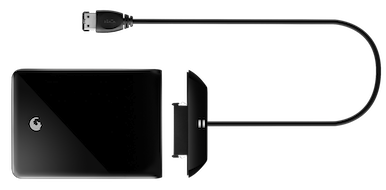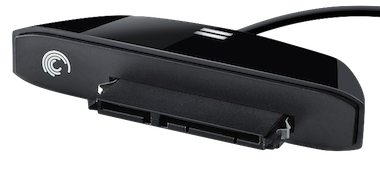
The external hard disk drive market is incredibly hot right now, but it’s also ultra-competitive. Stalwarts Seagate and Western Digital battle it out with everyone from disk makers like Toshiba and Hitachi to PC hardware companies like HP, Iomega, LaCie. The latest trend is dockable multi-function drives that are friendlier to use and offer advanced features like video playback. Most docks rely on USB 2.0, but Seagate just dropped a bomb on the industry with a simple twist: They moved the intelligence outside the case, repackaging the standard internal SATA connector as GoFlex, an external link to a variety of docks and adapters.
The Trouble With Hot Products
External drive makers face a dilemma: Fierce competition has driven down the price of external USB hard disk drives, hurting profit margins. Most brick-and-mortar stores sell basic external USB drives even cheaper than the bare hard disk mechanism contained inside, and sales can push them lower than online bulk drive purchases. It’s nice to be in a hot market, but not so great when it squeezes out all of the profit.
Drive makers responded by adding features. A few years back, the trend was upscale “pro” models with 400 or 800 megabit FireWire interfaces, one-touch backup software, or built-in encryption. We also saw “fashion” drives with sleek lines and bright colors. But these were one-sale sweeteners and did nothing for the brand as a whole. The next step was the introduction of desktop docking stations, encouraging the purchase of more devices from the same vendor. Then came a wave of video playback stations that connect to a television.
But all of these devices were limited by the USB 2.0 interface they used. USB was good enough for many uses, but it was too slow for some users. Those wanting faster performance simply ignored the dockable lines and went straight for FireWire 800, eSATA, or iSCSI over Gigabit Ethernet. The release of USB 3.0 forces vendors to scrap their current docks anyway.
What’s the Big Idea?
Seagate took these marketing lemons and turned them into lemonade. Their idea is simple: Move the interface and feature smarts outside the drive case and into the cable or dock. The GoFlex interface is almost identical to the standard SATA data and power interface found on physical hard disk drives. This gives plenty of performance, future-proofs the line as drive speeds increase, and allows a wider variety of interfaces to be used.

Let’s say you go out and buy a simple basic 500 GB FreeAgent GoFlex portable drive. It comes with the USB 2.0 cable but not much else. You can still get a TV dock like before, but now you can also order up some speed with a FireWire 800 or eSATA Upgrade Cable. And you can mix and match drives and cables, using eSATA with your desktop and USB with your notebook.
This is a win from Seagate’s perspective, too. Assuming they made the connector just different enough to not be compatible with other vendors’ SATA drives, they retain the brand lock-in advantage while offering enticing features to their customers. Assuming they eventually offer GoFlex drives without the cable as upgrades for existing users, the technology also allows them to underprice their competitors.
My Take
GoFlex is definitely a clever marketing idea, repackaging existing technology in a novel way. I am pleased to see an upgrade path to faster interfaces like USB 3.0 and eSATA, though I wish Apple would hurry up and offer these ports on their machines. And I am eager to try the technology out, especially with third-party drives.
I imagine that GoFlex will give Seagate quite a differentiator in a competitive market and will encourage brand loyalty among customers. But TV docks have not been a big success (judging from the clearance section at my local Best Buy) and I doubt this will change that situation. I expect this technology to be a hit, but drives will be drives.
Leave a Reply